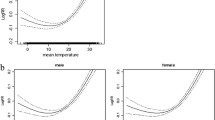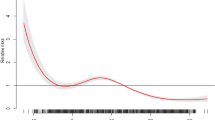Abstract
Extreme temperature has been reported to be associated with an increase in acute disease incidence in several cities. However, few similar studies were carried out in Shenzhen, which is a subtropical city located in the southern China. This study explored the relationship between the emergency incidences and extreme temperatures, and investigated the role of air pollutants played in the temperature-related effects on human health in Shenzhen. We conducted a distributed lag nonlinear model study on the effect of extreme temperatures on emergency incidences in Shenzhen city during 2013–2017. Here, only the total emergency incidences, emergency incidences for respiratory diseases, and cardiovascular diseases were taken into consideration. Air pollution, subgroups, and seasons were adjusted to investigate the impacts of extreme temperatures on emergency incidences. Relative risk (RR) and 95% confidence intervals were calculated with the R software. From lag 0 to 21 days, the RR of temperature-total emergency department visits, temperature-cardiovascular, and temperature-respiratory diseases was 1.09 (95% CI: 0.98–1.20), 1.22 (95% CI: 0.96–1.56), and 1.06 (95% CI: 0.70–1.60) at extremely low temperature (first percent of temperature, 10 °C), respectively. During the same lag days, the RR was 1.02 (95 % CI: 0.92–1.14), 0.64 (95% CI: 0.49–0.86), and 0.92 (95% CI: 0.56–1.53) between extremely high temperature and total emergency department visits, cardiovascular, and respiratory diseases, respectively. The cumulative effects gradually went up with time for all types of emergency incidences in warm seasons (5 days moving average of temperature < 22 °C). However, the cumulative effects of total emergency incidences and Cvd emergency incidences were increased within the first lag 5 days, and then decreased until lag 21 in hot seasons (5 days moving average of temperature ≥ 22 °C). The cumulative effects of Res emergency incidences showed a declined trend from lag 0 to lag 21. The elderly (≥ 65, P1: RR = 1.49, 95% CI (1.30, 1.71); P99: RR = 0.86, 95% CI (0.71, 1.04)) and men (P1: RR = 1.27, 95% CI (1.14, 1.42)) seemed to be more vulnerable to extreme temperature than the younger (≤ 64, P1: RR = 1.19, 95% CI (1.08, 1.32); P99: RR = 1.00, 95% CI (0.89, 1.12)) and women (P1: RR = 1.17, 95%CI (1.06, 1.30)). The effects of extremely low temperature on all types of emergency incidences were stronger than those of extremely high temperature in the whole year. In addition, impacts of cold weather lasted about several days while those of hot weather were acute and rapid. An increased frequency of emergency incidences is predicted by rising temperatures variations. These results have clinical and public health implications for the management of emergency incidences.









Similar content being viewed by others

References
Anderson BG, Bell ML (2009) Weather-related mortality: how heat, cold, and heat waves affect mortality in the United States. Epidemiology 20:205–213
Bassil KL, Cole DC, Moineddin R, Lou W, Craig AM, Schwartz B, Rea E (2011) The relationship between temperature and ambulance response calls for heat-related illness in Toronto, Ontario. 2005 J Epidemiology Community Health 65:829–831
Basu R, Dominici F, Samet JM (2005) Temperature and mortality among the elderly in the United States: a comparison of epidemiologic methods. Epidemiology 16:58–66
Borg M, Bi P, Nitschke M, Williams S, McDonald S (2017) The impact of daily temperature on renal disease incidence: an ecological study. Environ Health: A Global Access Sci Source 16:114
Bureau SS (2017): 2017 Shenzhen statistical yearbook
Curtis S, Fair A, Wistow J, Val DV, Oven K (2017) Impact of extreme weather events and climate change for health and social care systems. Environ Health: A Global Access Sci Source 16:128
D’Ippoliti D, Michelozzi P, Marino C, de’Donato F, Menne B, Katsouyanni K, Kirchmayer U, Analitis A, Medina-Ramon M, Paldy A, Atkinson R, Kovats S, Bisanti L, Schneider A, Lefranc A, Iniguez C, Perucci CA (2010) The impact of heat waves on mortality in 9 European cities: results from the EuroHEAT project. Environ Health: A Global Access Sci Source 9:37
Gasparrini A, Armstrong B, Kenward MG (2010) Distributed lag non-linear models. Stat Med 29:2224–2234
Guo Y, Barnett AG, Pan X, Yu W, Tong S (2011) The impact of temperature on mortality in Tianjin, China: a case-crossover design with a distributed lag nonlinear model. Environ Health Perspect 119:1719–1725
Luo Y, Zhang Y, Liu T, Rutherford S, Xu Y, Xu X, Wu W, Xiao J, Zeng W, Chu C, Ma W (2013) Lagged effect of diurnal temperature range on mortality in a subtropical megacity of China. PLoS One 8:e55280
Ma W, Wang L, Lin H, Liu T, Zhang Y, Rutherford S, Luo Y, Zeng W, Zhang Y, Wang X, Gu X, Chu C, Xiao J, Zhou M (2015a) The temperature-mortality relationship in China: an analysis from 66 Chinese communities. Environ Res 137:72–77
Ma W, Zeng W, Zhou M, Wang L, Rutherford S, Lin H, Liu T, Zhang Y, Xiao J, Zhang Y, Wang X, Gu X, Chu C (2015b) The short-term effect of heat waves on mortality and its modifiers in China: an analysis from 66 communities. Environ Int 75:103–109
Milazzo A, Giles LC, Zhang Y, Koehler AP, Hiller JE, Bi P (2016) Heatwaves differentially affect risk of Salmonella serotypes. J Infection 73:231–240
Onozuka D, Hagihara A (2016) Spatial and temporal variation in emergency transport during periods of extreme heat in Japan: a nationwide study. Sci Total Environ 544:220–229
Sun X, Sun Q, Yang M, Zhou X, Li X, Yu A, Geng F, Guo Y (2014) Effects of temperature and heat waves on emergency department visits and emergency ambulance dispatches in Pudong New Area, China: a time series analysis. Environ Health: a Global Access Sci Source 13:76
Tan J, Zheng Y, Song G, Kalkstein LS, Kalkstein AJ, Tang X (2007) Heat wave impacts on mortality in Shanghai, 1998 and 2003. Int J Biometeorol 51(3):193-200
Williams S, Bi P, Newbury J, Robinson G, Pisaniello D, Saniotis A, Hansen A (2013) Extreme heat and health: perspectives from health service providers in rural and remote communities in South Australia. Int J Environ Res Public Health 10:5565–5583
Xiao J, Peng J, Zhang Y, Liu T, Rutherford S, Lin H, Qian Z, Huang C, Luo Y, Zeng W, Chu C, Ma W (2015) How much does latitude modify temperature-mortality relationship in 13 eastern US cities? Int J Biometeorol 59:365–372
Zeng W, Lao X, Rutherford S, Xu, Y, Xu X, Lin H, Liu T, Luo Y, Xiao J, Hu M, Chu C, Ma W, (2014) The effect of heat waves on mortality and effect modifiers in four communities of Guangdong Province, China. Sci Total Environ 482-483, 214-221.
Acknowledgments
The authors would like to thank all the participants in our study.
Author contributions statement
Data curation: Guohong Zhou, Daokui Fang, and Tao Lan. FUNDING acquisition: Shuyuan Yu. Investigation: Yinsheng Guo and Guangwen Huang. Resources: Jiajia Ji and Ning Liu. Writing – original draft: Yue Ma. Writing – review and editing: Chaoqiong Peng.
Funding
This study was supported by the National Science Foundation of China (81773395), “Sanming Project of Medicine in Shenzhen” (SZSM201811070), and “Research Base for Environment and Health in Shenzhen Center for Disease Control and Prevention, Chinese Center for Disease Control and Prevention.”
Author information
Authors and Affiliations
Corresponding author
Ethics declarations
Competing interest statement
The authors declare that there is no conflict of interest in the present study.
Additional information
Responsible editor: Philippe Garrigues
Rights and permissions
About this article
Cite this article
Guo, Y., Ma, Y., Ji, J. et al. The relationship between extreme temperature and emergency incidences: a time series analysis in Shenzhen, China. Environ Sci Pollut Res 25, 36239–36255 (2018). https://doi.org/10.1007/s11356-018-3426-8
Received:
Accepted:
Published:
Issue Date:
DOI: https://doi.org/10.1007/s11356-018-3426-8



